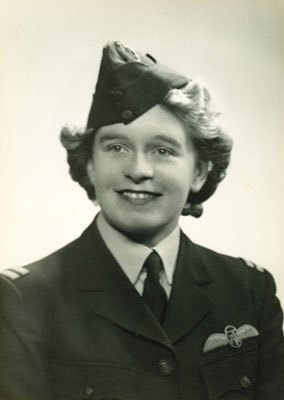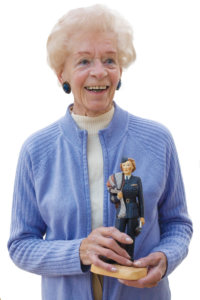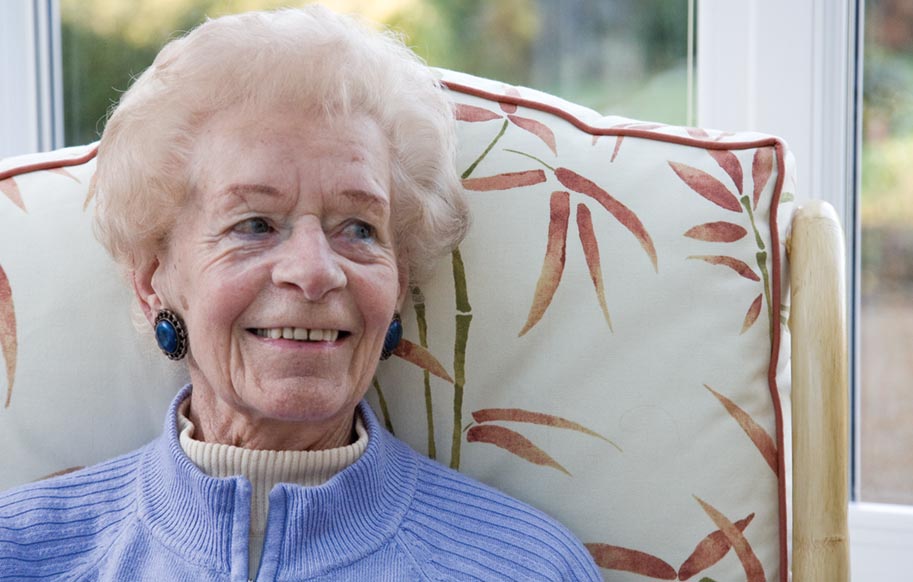It is not widely known that women were trained as pilots during the war, and played a vital part in the delivery of Hurricanes and Spitfires to airfields for active service. June Elford meets one former pilot who has never quite got over her love affair with flying.
Mary Ellis’ love affair with flying started before the war when her father took her to Sir Allan Cobham’s air show at Hendon and she persuaded him to let her take a pleasure flight in an Avro 504. “From that moment I was hooked,” says Mary and after learning to fly at Witney near Oxford, by the time she was sixteen she had obtained her Flying Licence.
So you can imagine her excitement in 1941 when she heard an appeal by the ATA on the radio for women pilots. She applied and was accepted after taking a flying test and told to report to Hatfield with a group of eight girls. They were trained to fly single fighters like Harvards, Hurricanes and Spitfires and later, when the Oxfords and Wellingtons were converted to twin types, all the other twin types in that class.
After her basic training Mary was based at No.15 Pool at Hamble, an all-women pool, and began to fly from aircraft factory aerodromes to airfields anywhere in Britain. In all, the ATA delivered 308,567 aircraft of 122 different types throughout the UK and Northern Ireland and Mary’s total (she calls it ‘modest’) was about 1,000 of 76 different types of military aircraft including 400 Spitfires. She was also one of only two girls to fly a Meteor jet at the end of the war when her sole briefing for the flight was to warn her that in 45 minutes the fuel would run out!
The ATA pilots’ job was dangerous – 143 of them were lost during the war in flying accidents including fourteen women – and the only navigational aids the pilots had were maps, a compass and a stop watch. Flying planes from factories to RAF and FAA airfields in open cockpits was cold and extremely uncomfortable and with no radio facilities, the pilots couldn’t be told about a change in the weather or warned where the balloon barrages were to be raised, popping up all over the sky in poor weather.
Each day the pilots would be taken to the aircraft factory aerodromes in a Fairchild or Anson taxi aircraft which carried 7 to 8 passengers. If any of the planes waiting to be ferried were urgently needed by a squadron,they had to be delivered even if visibility was poor.
The uniform the women pilots wore was a navy blue jacket, skirt or trousers, a pale blue shirt and a black tie. One of Mary’s treasured possessions is a statuette of a woman pilot in uniform with a parachute slung over her shoulder, one of a limited edition of 250. When Sir Stafford-Cripps, Minister of Aircraft Production paid a visit he was so impressed by the work the ATA pilots were doing (by 1943 they were ferrying thousands of aircraft every month) that he recommended the women should be paid the same as their male colleagues.
Mary flew continually for all the war years and though the ‘Attagirls’, as they were called, were entitled to two days off after a stretch of 14 days flying, she didn’t want the time off – Mary wanted to fly. She loved the ‘buzz’ when the plane took off but says it was the comprehensive pilots’ notes written by pilots and engineers that made it possible for her to fly any type of aircraft.
 And there’s the amusing story about a Wellington bomber Mary delivered. She had taxied the plane to a parking place but as she climbed down the ladder carrying her parachute, the ground crew asked where was the pilot. “I’m the pilot,” said Mary. They didn’t believe her and went to search the aircraft for the ‘missing pilot’.
And there’s the amusing story about a Wellington bomber Mary delivered. She had taxied the plane to a parking place but as she climbed down the ladder carrying her parachute, the ground crew asked where was the pilot. “I’m the pilot,” said Mary. They didn’t believe her and went to search the aircraft for the ‘missing pilot’.
On another occasion a not so funny thing happened when Mary and another girl had Priority 1 Spitfires to be delivered from Eastleigh to Wroughton. Urgently required Spitfires were labelled ‘P1 wait’ which meant the Spitfire must be delivered as soon as possible. The two girls took off independently in very poor visibility and Mary was glad to see the runway at Wroughton. She made a quick dash for the ground and was still going fast down the runway when she passed another Spitfire going in the opposite direction. Mary’s autograph book records the other girl said afterwards. “And next time we land on the same aerodrome, on the same runway, at the same moment, may we be going in the same direction!”
And the Spitfire that came looking for her? Mary had written her name on the coaming of a Spitfire she’d delivered towards the end of the war but the plane was never used in battle and eventually it was sold and shipped to Australia. When Robert Lamplough, a plane enthusiast, found the Spitfire and saw Mary’s name on the coaming he brought it back to Britain and started to search for her. Finally, he flew the plane into Sandown airport and First Officer Mary Wilkins (her title while in service) was reunited with the plane she’d last seen on a delivery flight during the war.
Two years ago Carolyn Grace, the only woman flying a Spitfire today, brought the plane to Sandown airport and persuaded Mary to fly with her. “I’ve waited years to get you into a Spitfire in the air,” Carolyn told her and handed over the controls to Mary. “The noise, the smell – it was absolutely marvellous,” Mary remembers. The single-seater Spitfires were called ‘the perfect ladies aeroplane’ because women pilots fitted into the small cockpit perfectly.
 After the ATA was disbanded at the end of the war Mary was seconded to RAF 41 Group and continued to ferry aircraft with the RAF. Post-war she was a personal pilot to her father’s friend, a wealthy farmer who later bought Sandown airport. Mary became the managing director – the only female commandant of an airport in Europe.
After the ATA was disbanded at the end of the war Mary was seconded to RAF 41 Group and continued to ferry aircraft with the RAF. Post-war she was a personal pilot to her father’s friend, a wealthy farmer who later bought Sandown airport. Mary became the managing director – the only female commandant of an airport in Europe.
She says the ATA pilots had the best of both worlds. “We were civilians in the forces,” she said. Called ‘the legion of the air’, the ATA was years ahead of its time in its attitude towards women and by embracing sexual equality the ATA became unique in wartime Britain. All the same, these extraordinary defiantly modern women, these unsung heroines, found it difficult to get jobs as pilots after the war.
The death rate amongst pilots in the ATA was 1 in 10 and each year the RAF acknowledges the vital role these pilots played in World War 11 with an annual memorial flight at RAF Lyneham. In a small garden at Manchester International Airport there’s a memorial to the ‘service, dedication and duty’ of the ATA pilots of Number 14 Ferry Pool and in 2006 a memorial to them was erected at White Waltham airfield in Berkshire. There is also a memorial in the Crypt of St. Paul’s Cathedral recording the history of the ATA. Last September a Spitfire and Hurricane flew low over White Waltham to launch a book Giles Whittell has written about women Spitfire pilots.
Today Mary says she has come to terms with advancing years and spends her time in the garden and corresponding with former colleagues. “I was lucky,’ she says, “I was born at the right time.”
‘Spitfire women of World War II’ by Giles Whittell is published by Harper Collins.



